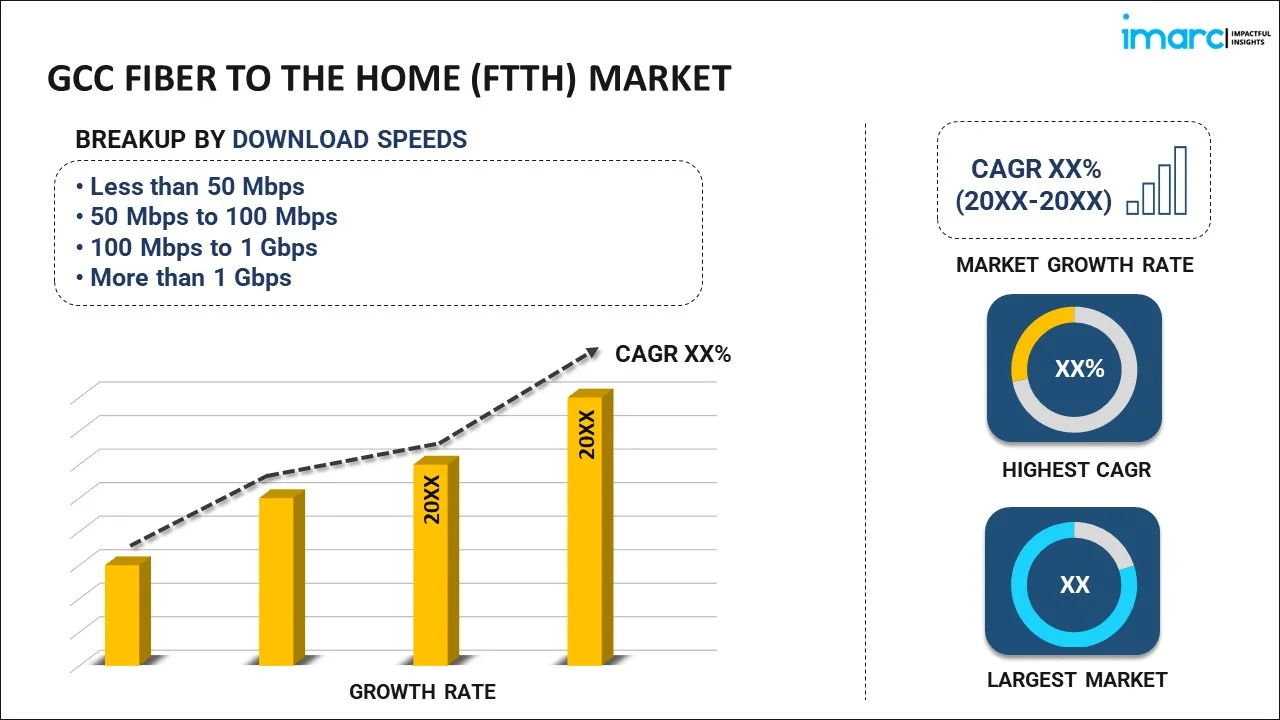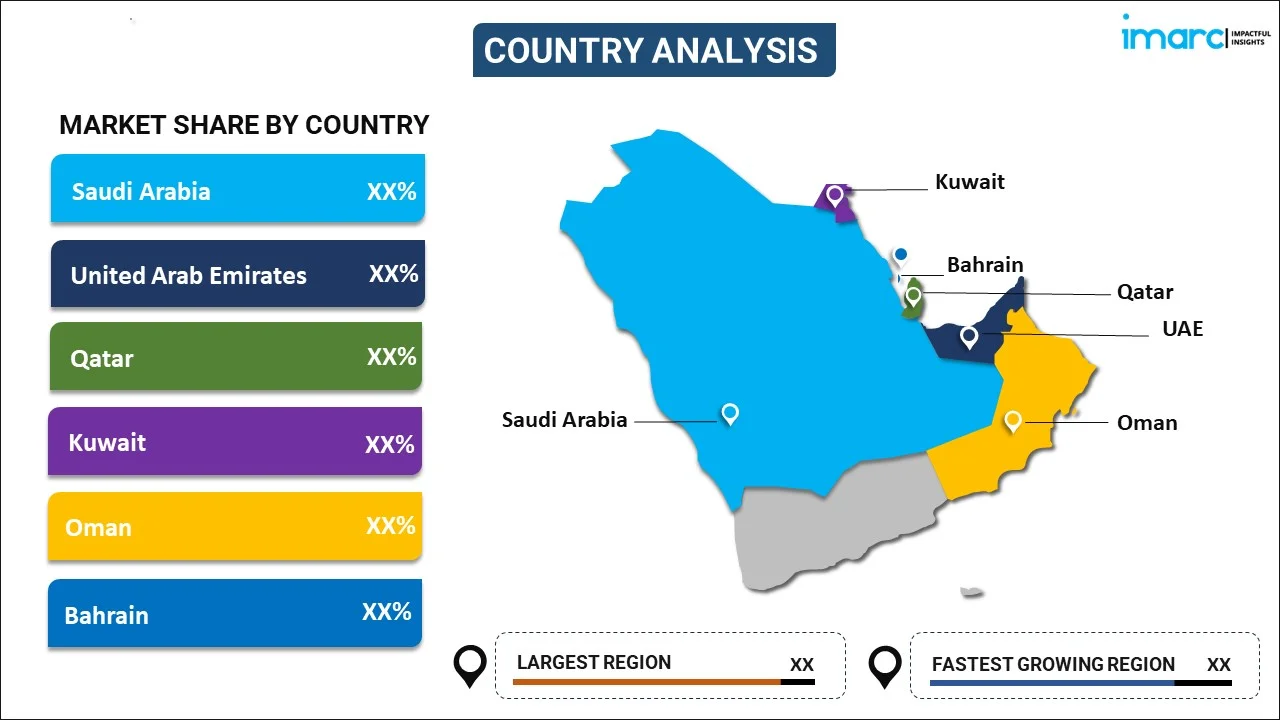
GCC Fiber to the Home (FTTH) Market Report by Download Speed (Less Than 50 Mbps, 50 Mbps To 100 Mbps, 100 Mbps To 1 Gbps, More Than 1 Gbps), Application (Internet TV, VoIP, Interactive Gaming, Remote Education, Smart Home Application, and Others), End User (Single Family Homes, Multiple Dwelling Units, Small Office Home Office), and Country 2025-2033
Market Overview:
The GCC fiber to the home (FTTH) market size reached USD 54.7 Billion in 2024. Looking forward, IMARC Group expects the market to reach USD 151.7 Billion by 2033, exhibiting a growth rate (CAGR) of 10.64% during 2025-2033. The rising smart city projects, rapid urbanization and infrastructure development, the increasing demand for high-quality streaming, gaming, and other data-intensive activities, rising competition among internet service providers, and the increasing need for reliable internet for remote work represent some of the key factors driving the market.
|
Report Attribute
|
Key Statistics
|
|---|---|
|
Base Year
|
2024 |
|
Forecast Years
|
2025-2033 |
|
Historical Years
|
2019-2024
|
| Market Size in 2024 | USD 54.7 Billion |
| Market Forecast in 2033 | USD 151.7 Billion |
| Market Growth Rate (2025-2033) | 10.64% |
Fiber to the home (FTTH) is a broadband network architecture that utilizes optical fiber to provide high-speed internet and digital communication services directly to residences and businesses. Unlike traditional copper-based networks, FTTH offers the advantage of higher data transmission rates, often reaching speeds of up to 1 gigabit per second or more. This architecture involves running fiber optic cables from a central point, commonly known as a hub, directly to individual homes or buildings. The key feature of FTTH is its capability to support much higher bandwidth compared to copper cables, making it ideal for data-intensive activities such as video streaming, online gaming, and telecommuting. Additionally, optical fiber is less susceptible to environmental conditions like electromagnetic interference, offering more reliable and consistent connectivity. FTTH is considered a future-proof technology because its infrastructure can be easily upgraded to meet increasing data demands without overhauling the entire network. While the initial investment for FTTH can be higher than that for copper-based networks, the long-term benefits, including lower maintenance costs and greater customer satisfaction, often make it a preferred choice for new installations and network upgrades.
GCC Fiber to the Home (FTTH) Market Trends:
The rising consumer demand for high-quality streaming, gaming, and other data-intensive activities represents one of the key factors driving the growth of the market across the GCC region. FTTH, with its superior speed and reliability, meets these high demands more effectively than traditional broadband networks, which is fueling its adoption. In line with this, governments in the GCC region are actively involved in the expansion of high-speed broadband connectivity which is contributing to the market growth. For instance, ambitious national visions like Saudi Arabia's Vision 2030 and UAE's Vision 2021 underline the importance of digital transformation, which promotes investments in FTTH infrastructure, thus influencing the growth of the market. As GCC countries are making efforts to diversify their economies away from oil and gas, there is an increasing emphasis on sectors like technology, healthcare, and education. This is facilitating the demand for fast and reliable internet connectivity, thus making FTTH a crucial infrastructure component. The growing and increasingly urbanized population in GCC is catalyzing the demand for high-quality digital services, which is driving the market growth. In addition to this, younger demographics are particularly tech-savvy and prefer seamless internet connectivity, thereby amplifying the need for robust FTTH networks, which is further boosting the demand for FTTH. Initiatives like Smart Dubai or NEOM in Saudi Arabia are aiming to integrate digital technologies into urban infrastructure which is facilitating the growth of the market. FTTH serves as the backbone for such smart city applications by offering the speed and reliability required for data analytics, IoT devices, and other advanced technologies, which is creating a positive outlook for the market across the region.
GCC Fiber to the Home (FTTH) Market Segmentation:
IMARC Group provides an analysis of the key trends in each segment of the GCC fiber to the home (FTTH) market report, along with forecasts at the regional and country levels for 2025-2033. Our report has categorized the market based on download speed, application, and end user.
Download Speed Insights:

- Less than 50 Mbps
- 50 Mbps to 100 Mbps
- 100 Mbps to 1 Gbps
- More than 1 Gbps
A detailed breakup and analysis of the market based on the download speed has also been provided in the report. This includes less than 50 Mbps, 50 Mbps to 100 Mbps, 100 Mbps to 1 Gbps, and more than 1 Gbps.
Application Insights:
- Internet TV
- VoIP
- Interactive Gaming
- Remote Education
- Smart Home Application
- Others
A detailed breakup and analysis of the market based on the application has also been provided in the report. This includes Internet TV, VoIP, interactive gaming, remote education, smart home application, and others.
End User Insights:
- Single Family Homes
- Multiple Dwelling Units
- Small Office Home Office
A detailed breakup and analysis of the market based on the end user has also been provided in the report. This includes single family homes, multiple dwelling units, and small office home office.
Country Insights:

- Saudi Arabia
- UAE
- Qatar
- Oman
- Kuwait
- Bahrain
The report has also provided a comprehensive analysis of all the major regional markets, which include Saudi Arabia, the UAE, Qatar, Oman, Kuwait, and Bahrain.
Competitive Landscape:
The report has also provided a comprehensive analysis of the competitive landscape in the GCC fiber to the home (FTTH) market. Competitive analysis such as market structure, key player positioning, top winning strategies, competitive dashboard, and company evaluation quadrant has been covered in the report. Also, detailed profiles of all major companies have been provided.
GCC Fiber to the Home (FTTH) Market Report Scope:
| Report Features | Details |
|---|---|
| Base Year of the Analysis | 2024 |
| Historical Period | 2019-2024 |
| Forecast Period | 2025-2033 |
| Units | Billion USD |
| Scope of the Report | Exploration of Historical and Forecast Trends, Industry Catalysts and Challenges, Segment-Wise Historical and Predictive Market Assessment:
|
| Download Speeds Covered | Less Than 50 Mbps, 50 Mbps To 100 Mbps, 100 Mbps To 1 Gbps, More Than 1 Gbps |
| Applications Covered | Internet TV, VoIP, Interactive Gaming, Remote Education, Smart Home Application, Others |
| End Users Covered | Single Family Homes, Multiple Dwelling Units, Small Office Home Office |
| Countries Covered | Saudi Arabia, the UAE, Qatar, Oman, Kuwait, Bahrain |
| Customization Scope | 10% Free Customization |
| Post-Sale Analyst Support | 10-12 Weeks |
| Delivery Format | PDF and Excel through Email (We can also provide the editable version of the report in PPT/Word format on special request) |
Key Questions Answered in This Report:
- How has the GCC fiber to the home (FTTH) market performed so far and how will it perform in the coming years?
- What has been the impact of COVID-19 on the GCC fiber to the home (FTTH) market?
- What is the breakup of the GCC fiber to the home (FTTH) market on the basis of download speed?
- What is the breakup of the GCC fiber to the home (FTTH) market on the basis of application?
- What is the breakup of the GCC fiber to the home (FTTH) market on the basis of end user?
- What are the various stages in the value chain of the GCC fiber to the home (FTTH) market?
- What are the key driving factors and challenges in the GCC fiber to the home (FTTH) market?
- What is the structure of the GCC fiber to the home (FTTH) market and who are the key players?
- What is the degree of competition in the GCC fiber to the home (FTTH) market?
Key Benefits for Stakeholders:
- IMARC’s report offers a comprehensive quantitative analysis of various market segments, historical and current market trends, market forecasts, and dynamics of the GCC fiber to the home (FTTH) market from 2019-2033.
- The research study provides the latest information on the market drivers, challenges, and opportunities in the GCC fiber to the home (FTTH) market.
- Porter's five forces analysis assist stakeholders in assessing the impact of new entrants, competitive rivalry, supplier power, buyer power, and the threat of substitution. It helps stakeholders to analyze the level of competition within the GCC fiber to the home (FTTH) industry and its attractiveness.
- Competitive landscape allows stakeholders to understand their competitive environment and provides an insight into the current positions of key players in the market.
Need more help?
- Speak to our experienced analysts for insights on the current market scenarios.
- Include additional segments and countries to customize the report as per your requirement.
- Gain an unparalleled competitive advantage in your domain by understanding how to utilize the report and positively impacting your operations and revenue.
- For further assistance, please connect with our analysts.
 Inquire Before Buying
Inquire Before Buying
 Speak to an Analyst
Speak to an Analyst
 Request Brochure
Request Brochure
 Request Customization
Request Customization




.webp)




.webp)












